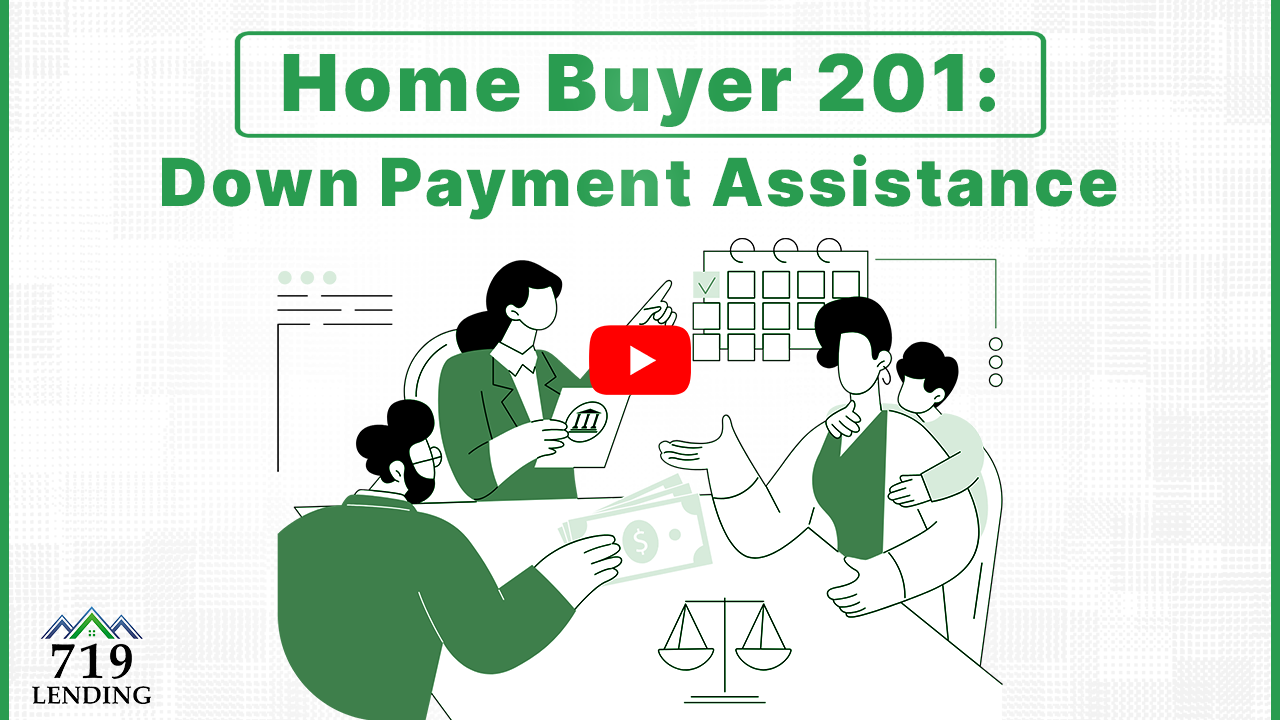6 minute lesson Lesson Summary Importance of timely document submission for your loan Types of…
Homebuyer 101: FHA Mortgage Insurance
Lesson Summary
-
FHA mortgage insurance, also known as MIP (mortgage insurance premium), is different from homeowner’s insurance.
-
It is an insurance policy that covers the lender in case the borrower defaults on the loan.
-
FHA loans have two levels of mortgage insurance: upfront mortgage insurance and monthly mortgage insurance.
-
Upfront mortgage insurance is added to the loan amount, while monthly mortgage insurance is included in the monthly payment.
-
Upfront mortgage insurance is typically 1.75% of the loan amount, while monthly mortgage insurance is around 0.85%.
-
FHA loans serve an important role in the home buying process by providing insurance to lenders, allowing borrowers to put down as little as 3.5%.
-
FHA mortgage insurance has made homeownership more accessible for the average American.
The allure of homeownership in Colorado Springs beckons many, with the majestic Rockies framing the city’s skyline. Navigating the path to this dream, you encounter various financial roads, paved with terms and conditions that, while essential, often appear complex. One such pathway leads through the realm of FHA loans—an option favored by many first-time buyers:
FHA mortgage insurance, or MIP, acts as a safeguard, not for you but for your lender.
As of early 2023, understanding the intricacies of FHA mortgage insurance becomes crucial in your home-buying journey, ensuring you step forward with confidence and clarity.
Understanding FHA Mortgage Insurance
The FHA Mortgage Insurance Premium (MIP) is a necessary policy, serving as collateral for lenders against defaults on low down payment loans. With MIP, you can secure an FHA loan with a minimum down payment of just 3.5%, broadening access to homeownership for a diverse range of buyers.
This insurance comprises two distinct costs: an upfront fee rolled into your loan amount, and a recurring monthly premium. Admittedly, they increase your loan’s cost, but they mitigate the lender’s risk, facilitating the opportunity for homeownership with smaller initial investments.
The Purpose of Mortgage Insurance Premium (MIP)
MIP encourages lenders to finance homebuyers with minimal down payments by offering protection against default.
FHA loans have boosted homeownership since the Great Depression, democratizing property acquisition.
Although it adds to the loan’s total cost, MIP reduces financial risk, enabling lenders to comfortably offer FHA loans.
Lastly, without MIP, the landscape of homeownership in America could be starkly different—with many priced out of the market.
Distinction Between MIP and Homeowners Insurance
It’s crucial to differentiate MIP from homeowners insurance; they serve separate, vital roles. MIP is specifically designed to protect lenders, not homeowners, from financial loss.
Whereas homeowners insurance provides a safety net for your property, covering damages from unforeseen events, MIP safeguards the lender if a borrower stops making payments. It’s an essential component when you have a lower down payment.
MIP requires both an upfront payment and ongoing premiums, often leading to confusion among buyers. Homeowners insurance, on the other hand, does not commonly require upfront costs and is billed annually or monthly.
Remember, while homeowners insurance claims benefit you directly by covering repair costs, MIP claims solely benefit your lender. They are two distinctly different forms of protection within the realm of homeownership.
Understanding this distinction ensures clarity in financial planning for your home purchase and helps avoid any surprises in the cost of borrowing.
Upfront MIP Explained
The Upfront Mortgage Insurance Premium (UFMIP) is an initial charge applied to FHA loans, calculated as a percentage of the loan amount. Its primary function is to ensure that lenders are compensated in the event of a loan default. Rather than being an out-of-pocket expense, this cost seamlessly integrates into your total loan balance, subtly increasing the amount you finance while spreading the impact over the life of the mortgage.
While the UFMIP might initially seem like an added burden, it’s a one-time cost that enables borrowers to access home ownership with less financial strain upfront. By capitalizing this expense, the FHA loan structure alleviates the immediate financial pressure, allowing homebuyers to allocate funds to other pivotal expenses like down payments and closing costs.
Calculating Your Upfront MIP Costs
Upfront Mortgage Insurance Premium (MIP) calculations are straightforward but crucial to your loan total.
- Determine the base loan amount: This is the initial amount you’re financing before any additional costs.
- Calculate the UFMIP: Multiply your base loan amount by the current UFMIP rate (typically 1.75%).
- Add the UFMIP to your loan: The resulting figure from step 2 is the UFMIP, which gets rolled into your loan balance.
Understanding these figures helps in assessing your true loan amount.
The UFMIP cost becomes part of your total mortgage, influencing your monthly payments.
Financing Upfront MIP in Your Loan
When you opt for an FHA loan, the Upfront Mortgage Insurance Premium (UFMIP) is wrapped into the loan balance.
- UFMIP is a one-time fee charged at closing, typically 1.75% of your loan amount.
- Rather than paying out of pocket, this premium gets capitalized, meaning it’s added to your initial loan balance.
- Your lender handles this integration seamlessly, ensuring you don’t have to manage additional payments at the outset.
Including UFMIP in your financing spreads the cost across the life of the loan, ensuring no upfront financial burden.
This enables FHA borrowers to maintain liquidity for other costs, solidifying the FHA’s role as a facilitator of homeownership.
Monthly MIP Breakdown
On top of your initial loan amount, FHA loans also require a recurring charge known as the Monthly Mortgage Insurance Premium (MIP). This fee, usually about 0.85% of your loan balance per year, is divided into 12 and paid monthly. This MIP guarantees that the lender remains protected in the event you default on your mortgage. It’s a fixed cost that, unlike other types of mortgage insurance, doesn’t decrease as your principal balance is paid down. Recognizing its role will help you plan financially for the ongoing costs associated with your FHA loan.
Determining Your Monthly MIP Payments
Calculating MIP requires mere arithmetic.
To compute your monthly MIP, take your loan amount and multiply it by the annual rate, then divide by 12. For example, a $200,000 loan at 0.85% would incur an annual MIP of $1,700, dividing by 12 results in approximately $141.67 per month. The precise amount, however, depends on the loan’s specific parameters.
You’ll pay this amount each month along with your mortgage.
This calculation reveals the incremental expense – the actual dollars added monthly to your payments. Remember, this figure is tethered to your initial loan amount and the respective MIP rate.
Your monthly MIP, once determined, remains consistent throughout the loan’s life.
Understanding this fixed cost is vital for fiscal planning, ensuring buyers are not caught off guard by the additional expenditure. As of 2023, these payments are an integral part of your financial obligations when utilizing an FHA loan. Planning for this helps secure the longevity of your homeownership journey.
The Permanence of Monthly MIP Charges
The monthly MIP associated with an FHA loan is not temporary; it’s a long-term commitment. Unlike other insurance elements that can fluctuate or be dropped entirely, this particular cost remains for the duration of the loan, absent refinancing or payoff.
It’s essential to grasp that this is a fixed expense. You won’t see it disappear or decrease over time.
Given its enduring nature, the monthly MIP should factor prominently in your budgeting. While principal and interest can eventually trend downward as equity builds, this insurance charge stays consistent, adding a significant sum over the lifecycle of your mortgage.
For those considering an FHA loan, grappling with the permanency of monthly MIP is crucial. It’s designed to safeguard the lender, not the borrower, and can considerably increase the overall cost of homeownership. It’s a tradeoff for the lower down payment requirement, emphasizing the need for a comprehensive understanding of your financial landscape and long-term goals. Consider it a “staple” in your housing expense sheet.
The Role of FHA in Homeownership
The FHA has played a foundational role in reshaping the American homeownership landscape. By requiring a mere 3.5% down payment, it widens the gateway to home buying for those who might find larger down payments prohibitive, thus fostering inclusivity and the dream of homeownership for a broader segment of the population.
This inclusive approach has not only democratized access to property ownership but has also instigated a ripple effect of financial empowerment. Through FHA’s framework, the barriers to entry are lowered, enabling more individuals and families to invest in their futures and cultivate generational wealth.
Advantages of Lower Down Payments
Lower down payments ease the initial financial burden, offering a quicker path to homeownership.
Consider the standard 20% down payment—quite sizable for most—which delays home purchases and can divert funds from other investments or savings goals. With FHA’s minimal 3.5% requirement, doors open sooner to the benefits of property ownership, including equity growth and potential tax advantages.
Lowering the upfront cost also democratizes housing affordability. It empowers more individuals, particularly first-time buyers and those with limited savings, to transition from renting to owning, often resulting in monthly mortgage payments comparable to or less than rental costs.
Furthermore, reduced initial outlays preserve cash reserves for other homeowner-related expenses. New owners can allocate funds toward home improvements, furnishings, and unexpected repairs, enhancing their living environment while maintaining financial flexibility.
How FHA Encourages Lender Confidence
The FHA’s Mortgage Insurance Premium (MIP) ensures lenders against losses if borrowers default, bolstering their willingness to lend to riskier borrowers. This security incentivizes lenders to offer loans with more favorable terms to a wider range of applicants.
By mitigating risk with its dual-layered mortgage insurance, FHA prompts financial institutions to lower barriers. These protections translate into lower required down payments and more lenient credit requirements.
In essence, the MIP functions as a safeguard, covering potential foreclosure costs, providing a safety net for lenders. Its presence reflects FHA’s commitment to maintaining stability within the housing market.
Thus, lenders gain confidence knowing the FHA-backed mortgage insurance shields them from the full impact of potential defaults. The upfront MIP and ongoing premiums serve as a protective buffer, ensuring lenders remain secure even as they extend credit to those with smaller down payments.
Historically, FHA’s intervention has enabled more equitable mortgage lending, addressing the inherent risks lenders face. Its insurance model has revolutionized the industry, facilitating homeownership for millions who might otherwise be excluded.
As a result, lenders can extend credit with the assurance that FHA’s insurance will reduce their exposure to loss. The FHA plays a critical role in aligning lender and borrower interests, fostering a more inclusive housing finance ecosystem.




